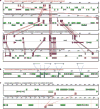Architecture and evolution of a minute plant genome
- PMID: 23665961
- PMCID: PMC4972453
- DOI: 10.1038/nature12132
Architecture and evolution of a minute plant genome
Abstract
It has been argued that the evolution of plant genome size is principally unidirectional and increasing owing to the varied action of whole-genome duplications (WGDs) and mobile element proliferation. However, extreme genome size reductions have been reported in the angiosperm family tree. Here we report the sequence of the 82-megabase genome of the carnivorous bladderwort plant Utricularia gibba. Despite its tiny size, the U. gibba genome accommodates a typical number of genes for a plant, with the main difference from other plant genomes arising from a drastic reduction in non-genic DNA. Unexpectedly, we identified at least three rounds of WGD in U. gibba since common ancestry with tomato (Solanum) and grape (Vitis). The compressed architecture of the U. gibba genome indicates that a small fraction of intergenic DNA, with few or no active retrotransposons, is sufficient to regulate and integrate all the processes required for the development and reproduction of a complex organism.
Conflict of interest statement
The authors declare no competing financial interests.
Figures



References
-
- Taylor P. The Genus Utricularia: a Taxonomic Monograph. Kew Publishing: 1989.
-
- Albert VA, Jobson RW, Michael TP, Taylor DJ. The carnivorous bladderwort (Utricularia, Lentibulariaceae): a system inflates. J Exp Bot. 2010;61:5–9. - PubMed
-
- Płachno BJ, Swiatek P. Unusual embryo structure in viviparous Utricularia nelumbifolia, with remarks on embryo evolution in genus Utricularia. Protoplasma. 2010;239:69–80. - PubMed
Publication types
MeSH terms
Substances
Grants and funding
LinkOut - more resources
Full Text Sources
Other Literature Sources
Molecular Biology Databases

